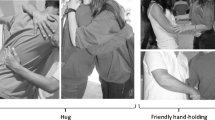Abstract
Watching another person being touched activates a similar neural circuit to actual touch and, for some people with 'mirror-touch' synesthesia, can produce a felt tactile sensation on their own body. In this study, we provide evidence for the existence of this type of synesthesia and show that it correlates with heightened empathic ability. This is consistent with the notion that we empathize with others through a process of simulation.


Similar content being viewed by others
References
Rizzolatti, G. et al. Brain 119, 593–609 (1996).
Buccino, G. et al. Eur. J. Neurosci. 13, 400–404 (2001).
Blakemore, S.J. et al. Brain 128, 1571–1583 (2005).
Keysers, C. et al. Neuron 42, 335–346 (2004).
Singer, T. et al. Science 303, 1157–1162 (2004).
Wicker, B. et al. Neuron 40, 655–664 (2003).
Gallese, V. & Goldman, A. Trends Cogn. Sci. 2, 493–501 (1998).
Gazzola, V., Aziz-Zadeh, L. & Keysers, C. Curr. Bio. 16, 1824–1829 (2006).
Dapretto, M. et al. Nat. Neurosci. 9, 28–30 (2005).
Oberman, L.M. et al. Brain Res. Cog. Brain Res. 24, 190–198 (2005).
Oberman, L.M. & Ramachandran, V.S. Psych. Bulletin 133, 310–327 (2007).
Baron-Cohen, S. et al. Phil. Trans. R. Soc. Lond. B 358, 361–374 (2003).
Lawrence, E.J. et al. Psychol. Med. 34, 911–924 (2004).
Lawrence, E.J. et al. Neuroimage 29, 1173–1184 (2006).
Acknowledgements
M.J.B. is supported by an Economic and Social Research Council studentship.
Author information
Authors and Affiliations
Contributions
M.J.B. conducted the experiments. J.W. devised the concept. The authors contributed equally in all other respects.
Corresponding author
Ethics declarations
Competing interests
The authors declare no competing financial interests.
Supplementary information
Supplementary Figure 1
Relationship between percentage of mirror-touch errors across each behavioural measure and scores on the emotional reactivity subscale of the EQ. (PDF 55 kb)
Supplementary Table 1
Participant details for the ten cases of mirror-touch synaesthesia. (PDF 40 kb)
Supplementary Table 2
Mean reaction times (± SD) on human trials within the faces experiment when control data was assigned to anatomical or specular spatial congruence according to the direction of difference between incongruent and congruent trials. (PDF 37 kb)
Supplementary Table 3
Mean reaction times (± SD) when discriminating the location of tap given to the left hand or right hand on left-right discrimination control blocks. (PDF 37 kb)
Rights and permissions
About this article
Cite this article
Banissy, M., Ward, J. Mirror-touch synesthesia is linked with empathy. Nat Neurosci 10, 815–816 (2007). https://doi.org/10.1038/nn1926
Received:
Accepted:
Published:
Issue Date:
DOI: https://doi.org/10.1038/nn1926
- Springer Nature America, Inc.
This article is cited by
-
Loving Objects: Can Autism Explain Objectophilia?
Archives of Sexual Behavior (2022)
-
Trait phenomenological control predicts experience of mirror synaesthesia and the rubber hand illusion
Nature Communications (2020)
-
A behavioral approach to shared mapping of peripersonal space between oneself and others
Scientific Reports (2018)
-
Offenders become the victim in virtual reality: impact of changing perspective in domestic violence
Scientific Reports (2018)
-
Phantom Acupuncture Induces Placebo Credibility and Vicarious Sensations: A Parallel fMRI Study of Low Back Pain Patients
Scientific Reports (2018)





